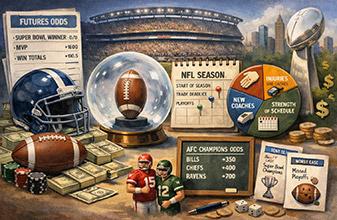Skillful handicappers and parlays

Sharp Sports Betting is a tool for those interested in winning money at sports betting. The book explains the most common sports bets, what all the numbers mean, and the mathematics behind the numbers.
Prospective sports bettors should know the basic principles of sports betting. Don’t bet online or anywhere else without this fundamental knowledge.
For a Break-Even Handicapper
Parlays off the board are not necessarily bad news for skillful handicappers.
Imagine a retired gentleman who lives in Las Vegas and whose expertise on sports allows him to pick 52.5 percent winners. Thus he is able to overcome the book’s vig on straight bets. In the long run his expectation is to break even on straight bets. He’s happy with that. His expertise allows him to while away the hours in sportsbooks without having to pay for his seat. He sometimes wins and sometimes loses, but his wins and losses fairly balance out — on straight bets.
How would this retired gentleman do on parlays? Is his expectation to win or to lose?
If he always picks teams that have 52.5 percent chance of winning, his expectation is to break even on parlays. He’ll experience larger risk with parlays, having bigger ups and bigger downs than with straight bets, but in the long run his parlay wins will roughly balance out his parlay losses. That’s true no matter how many teams he parlays, as long as he receives the odds shown below or better.
Parlay Odds Table
| Teams | True odds | -110 per team |
|---|---|---|
| 2 | 3:1 | 13:5 |
| 3 | 7:1 | 6:1 |
| 4 | 15:1 | 12:1 |
| 5 | 31:1 | 24:1 |
| 6 | 63:1 | 47:1 |
| 7 | 127:1 | 91:1 |
| 8 | 255:1 | 175:1 |
| 9 | 511:1 | 336:1 |
| 10 | 1,023:1 | 641:1 |
For a Winning Handicapper
Imagine a handicapper named Frank, who can pick more than 52.5 percent winners. What happens to parlays that Frank bets?
If Frank is good enough to win money at straight bets laying -110, then Frank is also good enough to win money at parlays, so long as he receives at least the odds shown in the third column of the table above.
Here is an example. Suppose Frank likes two teams and estimates each as having 55 percent chance of covering the spread. On straight bets at -110, Frank has the expectation of winning 5% on his bets.
Suppose he combines those two teams into a parlay at 13:5. If each bet has 55 percent chance to win and the two bets are independent, there is a 30.25 percent chance that the parlay will win. Getting 13:5 on the winner is a return of 8.9 percent on Frank’s bet.
If Frank is able to find another independent 55 percenter to combine with the first two in a three-team parlay at 6:1, all three teams will win 16.6 percent of the time and Frank can expect a return of 16.3 percent on the amount he wagers on the three-team parlay.
Thus Frank earns a higher rate of return on parlays than on straight bets. But parlays are also more risky: Frank wins 55 percent of his straight bets but only 30 percent of his two-teamers and 16.6 percent of his three-teamers.
One reason for Frank or any other winning handicapper to consider parlays is to get money down on a high-expected value situation. For example, if you want to bet a particular game to go over and the sportsbook has a $300 max on that bet, you might be able to parlay the over with something else for $500 without your bet affecting the line.
This is part of an occasional series of articles.
Excerpted with permission from Sharp Sports Betting by Stanford Wong, edited for this format.











Please log in or register to leave a comment